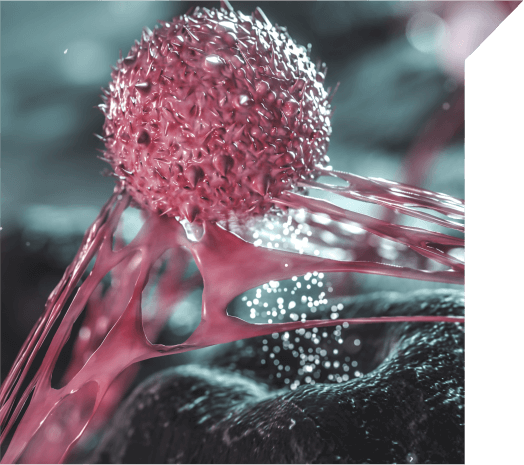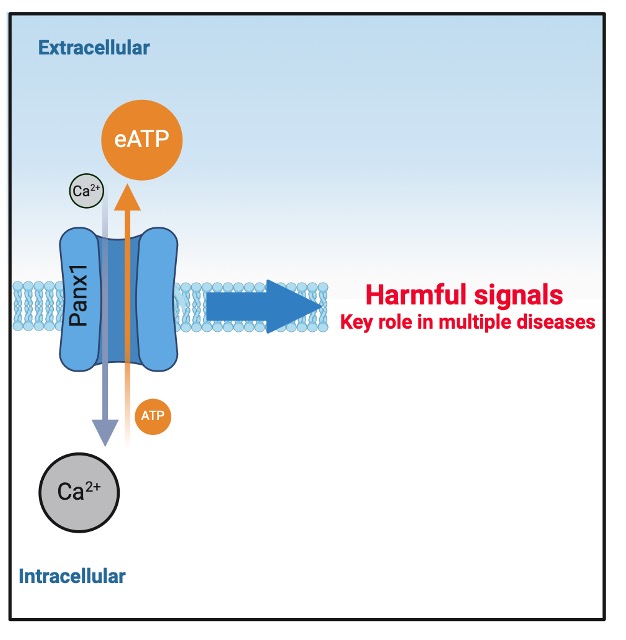
The discovery and validation of Panx1 opened a transformative pathway for developing selective blockers, offering new hope in treating cancers and neurological disorders. Pannex Therapeutics drives this innovation with its drug discovery platform.
Panx1’s role in multiple diseases

- Panx1 is a membrane channel and key regulator of ATP release and calcium (Ca) influx and plays a central role in many diseases.
- ATP (a key molecule for providing energy and a signalling molecule) is tightly regulated outside the cell. It is essential inside the cells, but too much ATP outside triggers harmful signals involved in diseases.
- Blocking Panx1 channels with small molecules reduces harmful signals, improving disease outcome.
By sparing healthy tissues, Panx1 blockers offer the potential for broad therapeutic impact with a favorable safety profile, as supported by early data.
Oncology
Our current focus area
Pannexin 1 channels are overexpressed in many cancers, playing a pivotal role in tumor progression. This stark difference between Panx 1 expression in tumor and surrounding tissue makes Panx1 a promising therapeutic target. Triple-negative breast cancer (TNBC) was chosen for advancing first into clinical trials.
TNBC is an aggressive subtype of breast cancer, that affects 15-20% of breast cancer patients, has limited treatment options and a poor prognosis, with less than 10% of advanced-stage patients surviving beyond five years.
Blocking Panx1 addresses key tumor functions, such as inhibiting growth, metastasis, and invasion, while increasing the tumors vulnerability to the immune system. Preliminary findings highlight a good safety profile of the drug class and potential for precision medicine.
Neurology
Panx1 plays a pivotal role in amplifying pathological signaling in a wide range of neurological diseases, including chronic pain, multiple sclerosis (MS), opioid addiction, epilepsy, and depression. These diseases represent areas of substantial unmet medical need, highlighting the demand for novel treatment strategies.
Targeting Panx1 allows for the modulation of key signaling and inflammatory pathways involved in these disorders, offering promise in addressing these diseases.
As part of our ongoing preclinical development program, we have already achieved significant results, showcasing the efficacy of our blockers in animal models for triple negative breast cancer, chronic pain, and opioid withdrawal and are exploring other cancers and neurological disorders.
Selected scientific publications
Panx1 in cancer:
1. Laird, D. W., & Penuela, S. (2021). Pannexin biology and emerging linkages to cancer. Trends in Cancer, 7(12), 1119-1131.
2. Jalaleddine, N., El-Hajjar, L., Dakik, H., Shaito, A., Saliba, J., Safi, R., … & El-Sabban, M. (2019). Pannexin1 is associated with enhanced epithelial-to-mesenchymal transition in human patient breast cancer tissues and in breast cancer cell lines. Cancers, 11(12), 1967.
3. Furlow, P. W., Zhang, S., Soong, T. D., Halberg, N., Goodarzi, H., Mangrum, C., … & Tavazoie, S. F. (2015). Mechanosensitive pannexin-1 channels mediate microvascular metastatic cell survival. Nature cell biology, 17(7), 943-952.
4. Chen, Wuzhen, et al. “High PANX1 Expression Leads to Neutrophil Recruitment and the Formation of a High Adenosine Immunosuppressive Tumor Microenvironment in Basal-like Breast Cancer.” Cancers 14.14 (2022): 3369.
5. Bao L, Sun K, Zhang X. PANX1 is a potential prognostic biomarker associated with immune infiltration in pancreatic adenocarcinoma: A pan-cancer analysis. Channels (Austin). 2021 Dec;15(1):680-696.
6. Shi G, Liu C, Yang Y, Song L, Liu X, Wang C, Peng Z, Li H, Zhong L. Panx1 promotes invasion-metastasis cascade in hepatocellularcarcinoma. J Cancer. 2019 Sep 7;10(23):5681-5688.
Panx1 in general:
1. Navis KE, Fan CY, Trang T, Thompson RJ, Derksen DJ. Pannexin 1 Channels as a Therapeutic Target: Structure, Inhibition, and Outlook. ACS Chem Neurosci. 2020 Aug 5;11(15):2163-2172. doi: 10.1021/acschemneuro.0c00333. Epub 2020 Jul 20. PMID: 32639715.
2. Sanchez-Arias JC, van der Slagt E, Vecchiarelli HA, Candlish RC, York N, Young PA, Shevtsova O, Juma A, Tremblay MÈ, Swayne LA. Purinergic signaling in nervous system health and disease: Focus on pannexin 1. Pharmacol Ther. 2021 Sep;225:107840.
3. Bhat EA, Sajjad N. Human Pannexin 1 channel: Insight in structure-function mechanism and its potential physiological roles. Mol Cell Biochem. 2021 Mar;476(3):1529-1540.
